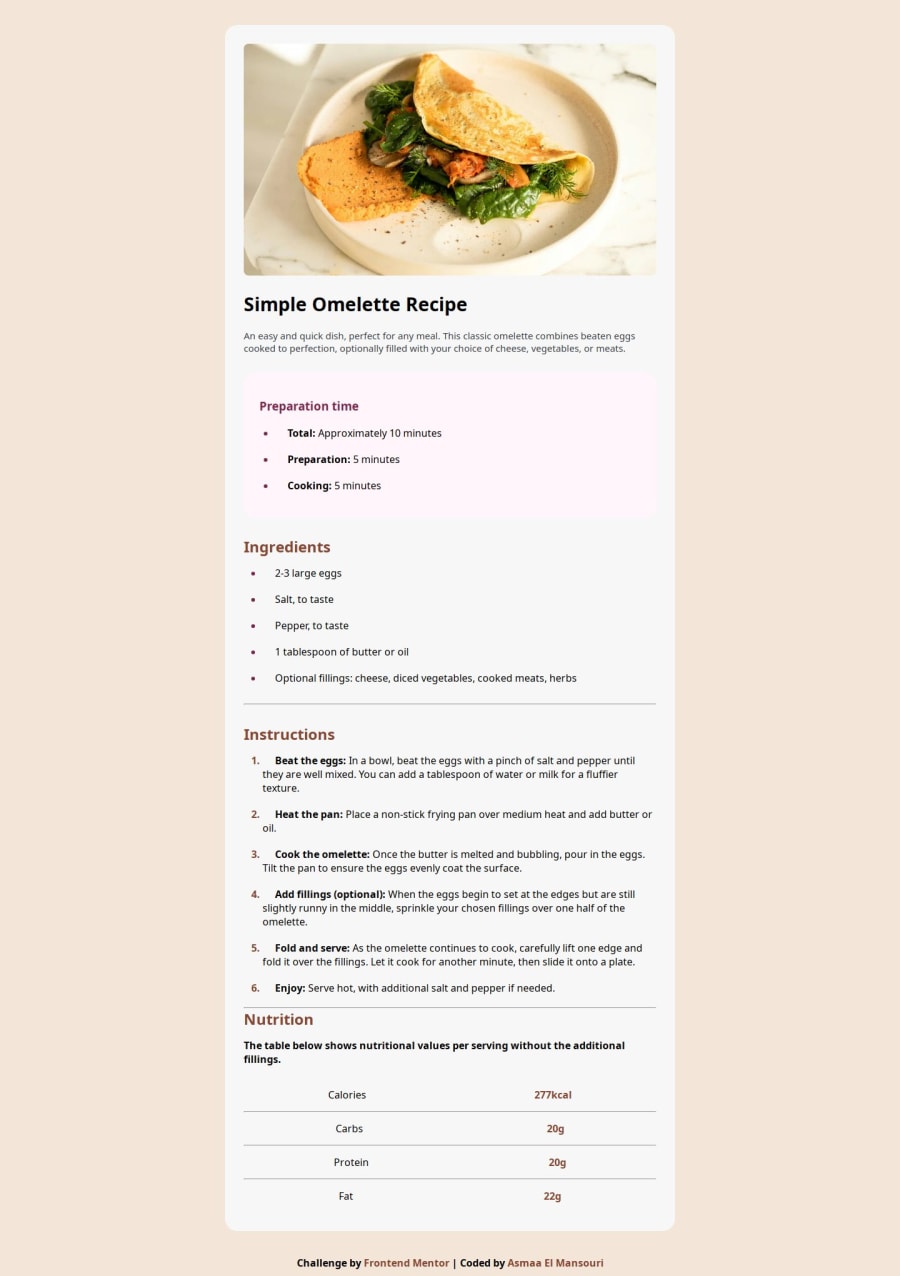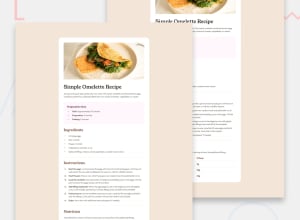
Design comparison
SolutionDesign
Community feedback
- @josemguerraPosted 3 months ago
Feedback for "Simple Omelette Recipe" Code
1. Semantic HTML
- Strengths:
- Good use of semantic tags like
<article>,<h1>,<h2>, and<footer>to structure the content logically. - The
<ol>and<ul>lists are appropriately used for ordered steps and unordered ingredients.
- Good use of semantic tags like
- Improvements:
- Consider wrapping the nutrition section in a
<section>tag with an appropriate heading for improved semantic clarity. - Use
<figure>and<figcaption>for the recipe image to enhance semantic structure and allow for additional descriptive text.
- Consider wrapping the nutrition section in a
2. Accessibility
- Strengths:
- Includes
alttext for the image, which is essential for accessibility.
- Includes
- Improvements:
- The
alttext could be more descriptive, e.g.,"Plate of an omelette with garnishes", to provide better context. - Add ARIA landmarks where appropriate, such as
role="contentinfo"for the footer orrole="main"for the<article>. - Ensure sufficient color contrast for text and backgrounds to meet WCAG guidelines.
- The
3. Responsive Design
- Strengths:
- The structure supports responsive styling, especially with the use of clean class names.
- Improvements:
- Test the layout on various screen sizes to ensure images and text scale properly.
- Use CSS media queries to adjust the layout, such as stacking the nutrition details vertically on smaller screens.
4. Code Structure, Readability, and Reusability
- Strengths:
- The HTML is well-organized and easy to read, with consistent indentation.
- Class names like
recipe-title,meal-description, andpreparation-timeare descriptive and maintainable.
- Improvements:
- Add comments to indicate the purpose of major sections.
- Avoid inline styles (e.g.,
hrstyles should be moved tostyles.cssfor better maintainability).
5. Consistency with Design
- Strengths:
- The hierarchy of headings and spacing between sections makes the content easy to follow.
- Improvements:
- Ensure alignment, spacing, and typography match the intended design. For example, ensure consistent margins between sections like Ingredients and Instructions.
6. Additional Suggestions
- Include metadata like
<meta name="description" content="Simple omelette recipe with step-by-step instructions, ingredients, and nutrition facts">for better SEO. - Use
<table>instead of<div>for the nutrition details, as tabular data is semantically better suited for a table.
Summary of Suggestions:
- Enhance accessibility with more descriptive
alttext and ARIA landmarks. - Wrap sections like nutrition in a
<section>for better semantic structure. - Improve layout responsiveness with media queries.
- Consider using
<figure>and<table>for images and nutrition data, respectively.
Overall, this is a strong implementation with clear structure and good use of semantic HTML. With minor improvements, it can become even more accessible, responsive, and maintainable.
Marked as helpful0 - Strengths:
Please log in to post a comment
Log in with GitHubJoin our Discord community
Join thousands of Frontend Mentor community members taking the challenges, sharing resources, helping each other, and chatting about all things front-end!
Join our Discord
